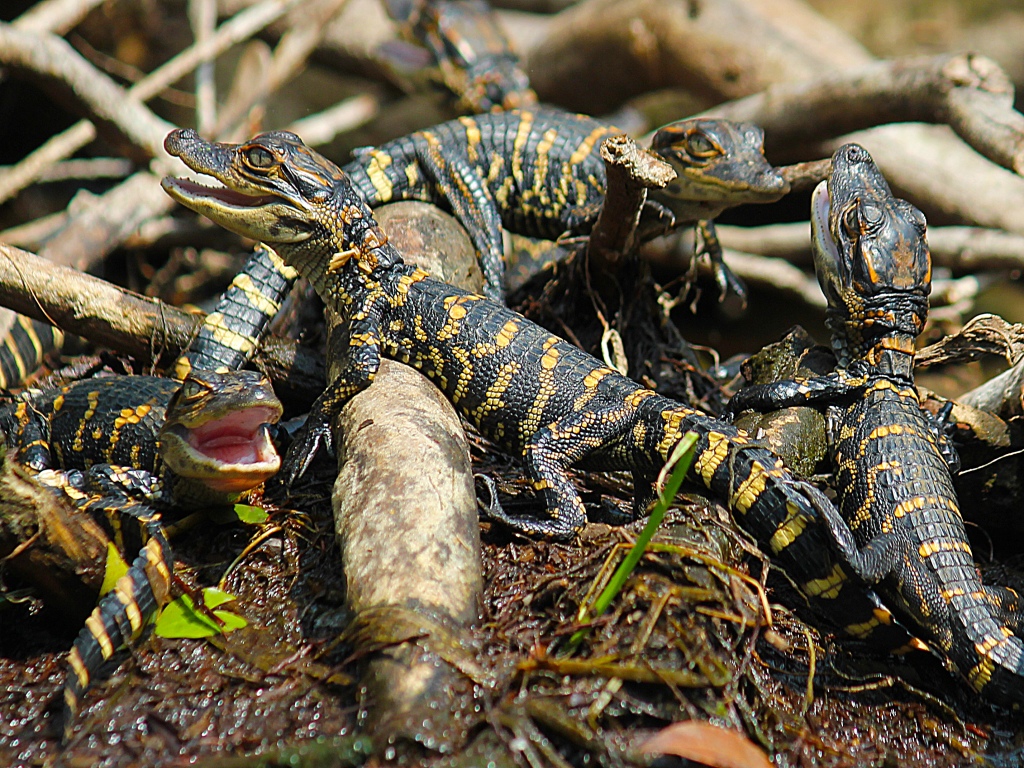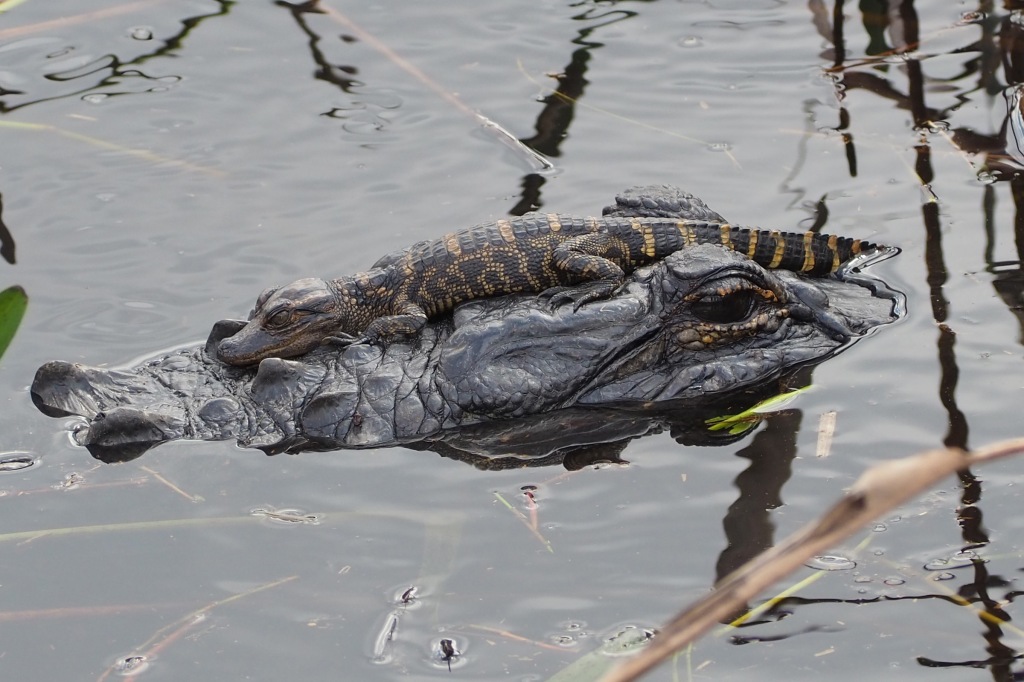Summer’s beginning to set in. There’s a heavy heat settled over everything like a thick, wet blanket. In the distance, a sound ripples through the night, inspiring both awe and terror. It’s the sort of sound that you could admire from afar, but would be hesitant to get too close to. It’s the sort of sound that started deep in the belly of one ancient creature and rumbled out of the jaws of another, generations down the line. That sound is the low, rolling bellow of Alligator mississippiensis–better known as the American alligator.
The American alligator is a large, long-lived crocodilian native to the United States of America. Some people might even say that it is the large, long-lived reptile. They wouldn’t be completely wrong; these impressive animals can reach sizes of 12 feet long and 1,000 pounds [1], making them the largest reptile found in the United States. While male “gators” are typically larger, American alligators of both sexes continue growing for their entire lives. But everyone has to start somewhere, right? For American alligators, that starting place is in the humble egg.
Alligators come from eggs, and eggs come from courtship. The warm summer weather kicks off the American alligator’s breeding season throughout the southern regions of the U.S., when the evening air fills with their distinctive bellow. The bellow serves several purposes, with mate competition and courtship being big ones. In addition, their “infrasonic” signaling ripples the water at a frequency lower than we can even hear, while they call out with their heads and tails held high [2]. Male alligators are also known to perform a “headslap” behavior; this distinctive display is a combination of several acts, culminating with clapping their jaws together as they smack the underside of their head against the water below [2]. The sight is undeniably impressive.
Source: BBC Earth.
Females begin nesting on the tail end of the breeding season, starting around June. That’s right; nesting isn’t just for the birds! Once they’ve picked a location–usually up on the dry banks of their waterways–the females will begin homesteading. They build nest sites from mud and vegetation, where they lay and then cover their eggs. Each clutch (or group of eggs) can contain as many as 40-45 eggs [3]. They are kept nice and warm by the surrounding mud and nest debris, but did you know, temperature is not only important for the eggs’ survival? It is also important for determining the sex of the hatchlings. Colder temperatures produce more females, whereas warmer temperatures produce more males [3].

Photo Credit: NPS photo by Lori Oberhofner [Source].
Building, maintaining, and protecting her nest from ill-doers is an important part of the female American alligator’s parental care behavior. However, her obligations to her young don’t stop there. In the late summer, the young alligators (still inside their eggs) begin making chirping calls to alert their doting mother that they are nearly ready [1]. After hatching, the young will form a group or “pod” and stick together for as long as three years while they grow [3]. Life outside the shell is much more dangerous for a wee little gator than it was in the nest. Hatchlings are preyed on by otters, raccoons, birds, other gators, and even some fish. Human interaction also poses a significant risk for young and old gators alike, and hunting nearly decimated this species in the 1950s and 60s [4]. A female alligator has her work cut out for her to protect her offspring. Of course she is, in fact, an excellent provider of parental care in a dangerous world. Young gators will remain in their home range while they are still growing “juveniles,” staying safely under the mother alligator’s vigilant watch [5].

Photo Credit: William Stamps Howard [Source].
The life of a long-lived reptile is more of a marathon than a sprint. Nonetheless, as it grows, a gator begins its lumbering crawl up the food chain. The hatchlings initially depend on their egg yolks to provide food, before feeding on smaller animals like fish and snails. As they get older, hatchlings are soon able to feed on a versatile diet of crabs, snakes, amphibians, insects, and even unsuspecting dry-land animals that make their way to the water’s edge for a drink. The largest American alligators are known to occasionally feast on deer, birds, and the very raccoons that once threatened their younger selves [3]. The only threat to a big gator is mostly just other alligators. Other adult gators will eventually drive them out of their birth range, if they don’t venture out on their own to find resources first [5]. Thus, the cycle is able to begin again!

By now, I have hopefully done a good job of highlighting why the American alligator is one of the most impressive reptiles around. If you’re still not convinced, however, perhaps these final fun facts can sway you:
- They have their very own set of natural armor, and their skin is adorned with bony plates called “scutes.” [5]
- Gators are born with yellow and black stripes in a pattern that is unique to each individual, and darkens as they age. [5]
- An American alligator’s jaw is strong enough to crack a turtle shell! They use this extra strong biting power to grab a hold of large prey and perform an impressive rolling behavior to subdue it [5].
Thanks for reading! We’ll see you later, alligators… Or in a while, if you prefer crocodiles.
Written by: Cassidy Cooper is a PhD candidate in the Animal Behavior Graduate Group at UC Davis in the Fangue Lab. Her current research focuses on how variable environments drive physiology and social interactions in Chinook salmon. When she’s not keeping company with fish, she’s off on adventures with her dog, horses, and other various vertebrate friends.
References
[1] National Wildlife Foundation: https://www.nwf.org/Educational-Resources/Wildlife-Guide/Reptiles/American-Alligator
[2] Vliet, K.A., 1989. Social displays of the American alligator (Alligator mississippiensis). American Zoologist, 29(3), pp.1019-1031.
[3] South Carolina Department of Natural Resources: https://www.dnr.sc.gov/marine/mrri/acechar/speciesgallery/Reptiles/AmericanAlligator/index.html#:~:text=The%20largest%20alligator%20on%20record,heavy%20animals%20are%20quite%20uncommon.
[4] U.S. Fish and Wildlife Service. 1987. Reclassification of the American alligator to threatened due to similarity of appearance throughout the remainder of its range. June 4, 1987 (52 FR 21059)
[5] Smithsonian’s National Zoo and Biology Institute: https://nationalzoo.si.edu/animals/american-alligator
[Edited by Alice Michel & Jacob Johnson]